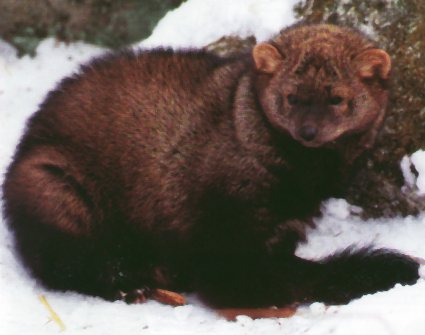
Fisher

Order: Carnivora Family: Mustelidae Genus & Species: Martes pennanti
Found in the forests of Canada, from British Columbia in the west, eastwards to Quebec. Also occurs in parts of the northern USA. The fisher is one of the few creatures that is daring enough and skilled enough to attack and kill a porcupine.
| Habitat The fisher is found in the dense coniferous forests of North America. It prefers lowland conifer forests, with thick strands of pine and firs, where it finds safety from aerial predators, such as the spotted owl. It avoids clearings and other open areas and seems to shun woodland containing aspen-birch and hemlock treees. In high altitude habitats, such as Sierra Nevada mountains, the fisher stays close to the shelter of rock ridges. |
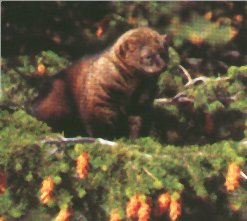 |
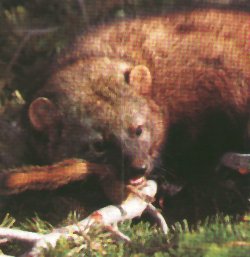 |
Behaviour The fisher tends to be solitary, except during the breeding season. An individuals home range can cover up to 35 sq km but is generally smaller. Home ranges of animals of the same sex do not overlap although the range of a male may encompass those of several females. In areas where the forest remains undisturbed and food is plentiful, there may be one fisher per 3 sq km. The fisher seeks temporary shelter in hollow trees, logs and holes in the ground. |
| If the feeding is good and the fisher is putting on fat, it sleeps for
long periods. If disturbed, it hunches its back like a cat and snarls and hisses
fiercely. |
Feeding The fisher usually feeds on the ground, but will often climb trees, where it surprises or chases mammals, such as squirrels, and roosting birds or nestlings. In some areas, porcupines are a preferred prey, accounting for a quarter of the fisher's diet. A 5kg porcupine, the same weight as the fisher itself, may provide enough food for about ten days. Usually, though, the fisher catches smaller prey and hunts regularly to fuel its energetic hunting missions. |
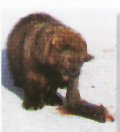 |
| To satisfy its hunger, the fisher's typical daily intake might be a
couple of squirrels or chipmunks or up to a dozen mice.Carrion features in the fisher's
diet. Carcasses too large to eat at one sitting are sprayed with powerfully scented
urine to ward off other scavengers. The fisher may also scent mark large prey in the
same way. |
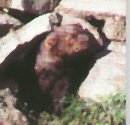 |
Breeding During the spring breeding season, the male fisher roams beyond its territory in search of females. Although mating occurs between March and May, implantation of the fertilized eggs in the uterus does not take place until the following January to early April. This ensures that the kits are born just before the summer, when food is becoming more plentiful. The female is thought to mate within ten days of giving birth to the litter conceived the |
| previous year, and so is continually pregnant. The single brood of up to six kits is born blind and partly covered with fine hair, usually in a rock crevice or hollow tree. They are weaned at around five months old. |